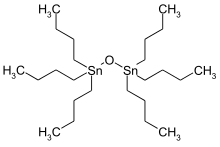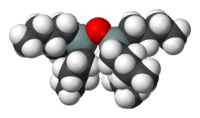Tributyltin oxide
 | |
 | |
| Names | |
|---|---|
| Other names
, bis(tri-n-butyltin)oxide, AW 75-D, Bio-Met TBTO, Biomet, Biomet 75, BTO, Butinox, C-SN-9, hexabutyldistannoxane | |
| Identifiers | |
| 56-35-9 | |
| 3D model (Jmol) | Interactive image |
| ChEMBL | ChEMBL511667 |
| ChemSpider | 10218152 |
| ECHA InfoCard | 100.000.244 |
| KEGG | C18149 |
| PubChem | 16682746 |
| |
| |
| Properties | |
| C24H54OSn2 | |
| Molar mass | 596.112 |
| Melting point | −45 °C (−49 °F; 228 K) |
| Boiling point | 180 °C (356 °F; 453 K) at 2 mm Hg |
| 0.002 g/100 mL | |
| Hazards | |
| R-phrases | R21 R25 R36/38 R48/23/25 R50/53 |
| S-phrases | S36/37/39 S45 S60 S61 |
| Except where otherwise noted, data are given for materials in their standard state (at 25 °C [77 °F], 100 kPa). | |
| | |
| Infobox references | |
Tributyltin oxide (TBTO) is an organotin compound chiefly used as a biocide (fungicide and molluscicide), especially a wood preservative. Its chemical formula is [(C4H9)3Sn]2O. It has the form of a colorless to pale yellow liquid that is only slightly soluble in water (20 ppm) but highly soluble in organic solvents. It is a potent skin irritant.
Tributyltin compounds had been used as marine anti-biofouling agents. Concerns over toxicity of these compounds have led to a worldwide ban by the International Maritime Organization.[1] It is now considered a severe marine pollutant and a Substance of very high concern by the EU.[2]
References
- ↑ "Focus on IMO - Anti-fouling systems" (PDF). International Maritime Organisation.
- ↑ Organotin Chemistry, Second Edition. Alwyn G. Davies, 2004, Wiley-VCH Verlag GmbH & Co. KGaA. ISBN 3-527-31023-1
External links
- National Pollutant Inventory Fact Sheet for organotins
- Tributyltin oxide use
- Tributyltin oxide in the Pesticide Properties DataBase (PPDB)
This article is issued from Wikipedia - version of the 7/16/2015. The text is available under the Creative Commons Attribution/Share Alike but additional terms may apply for the media files.